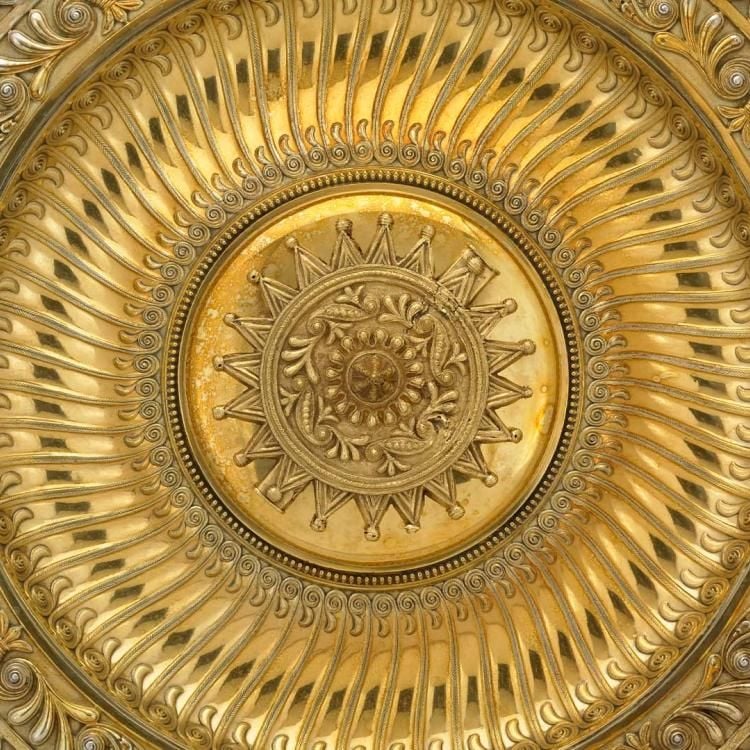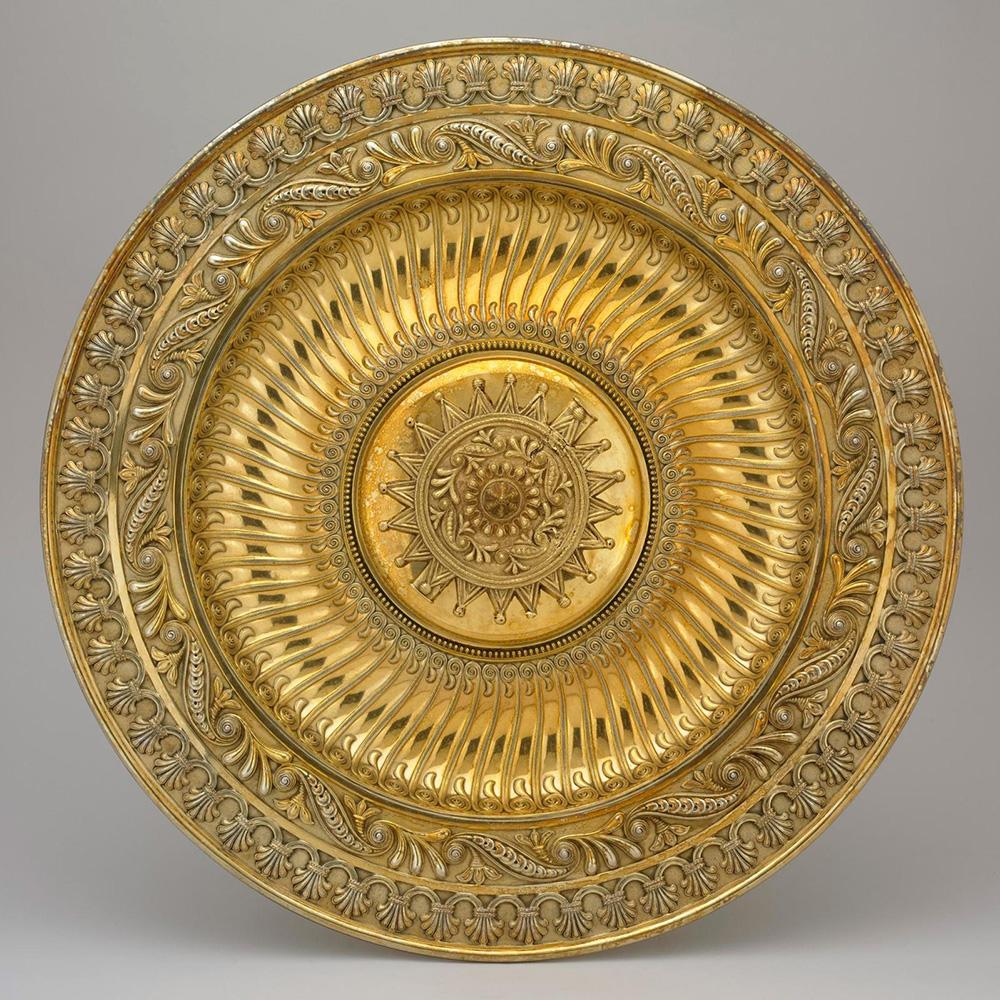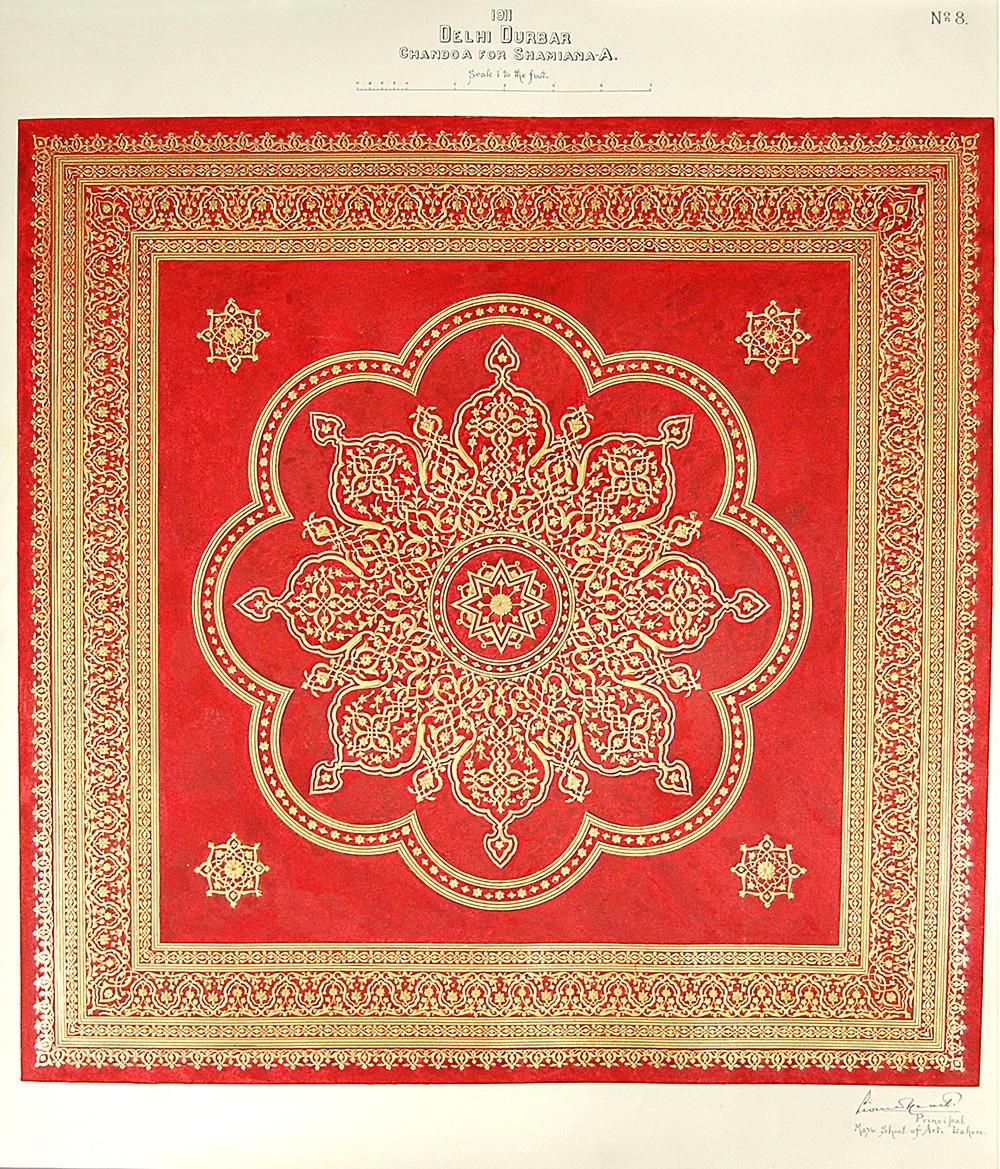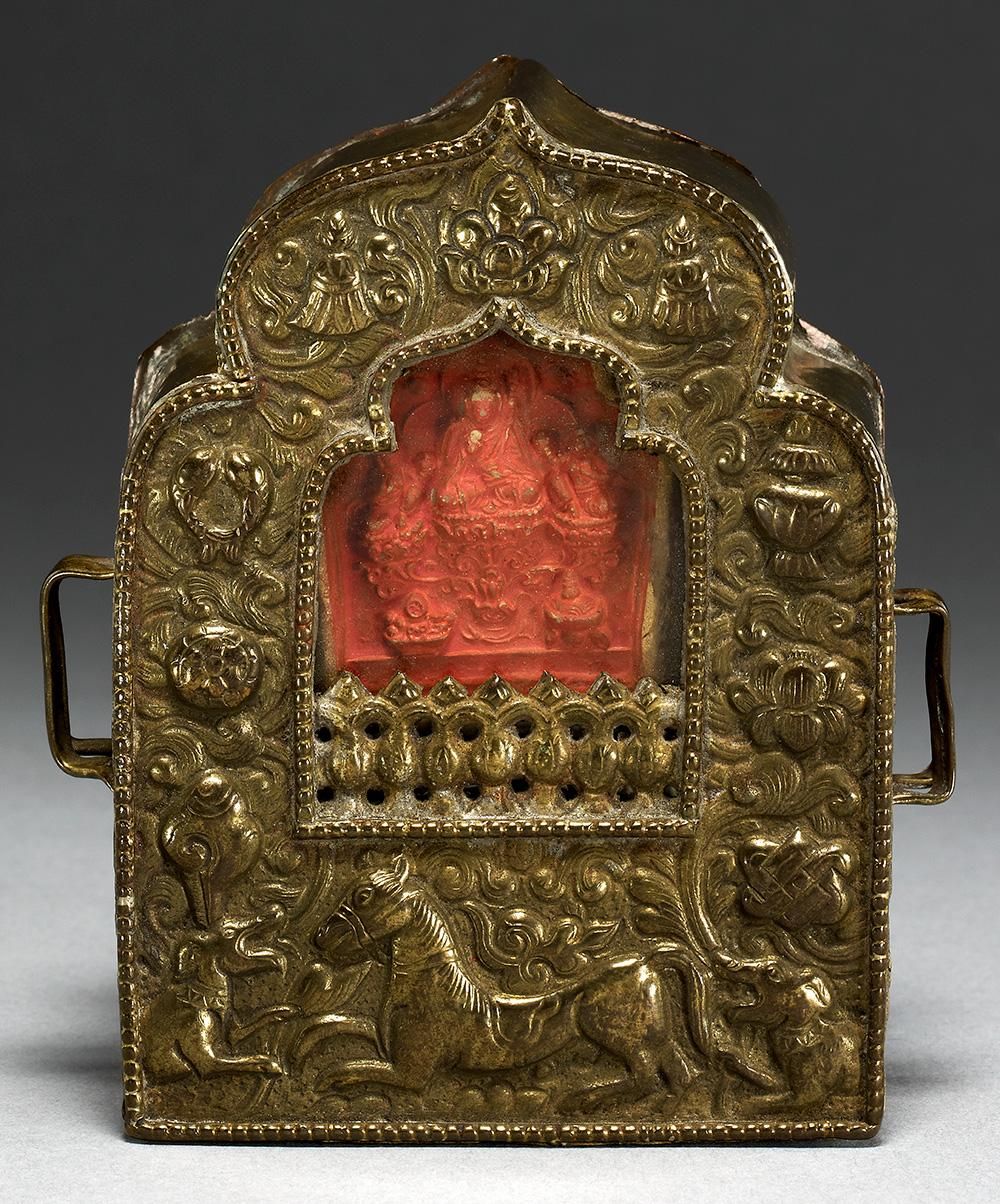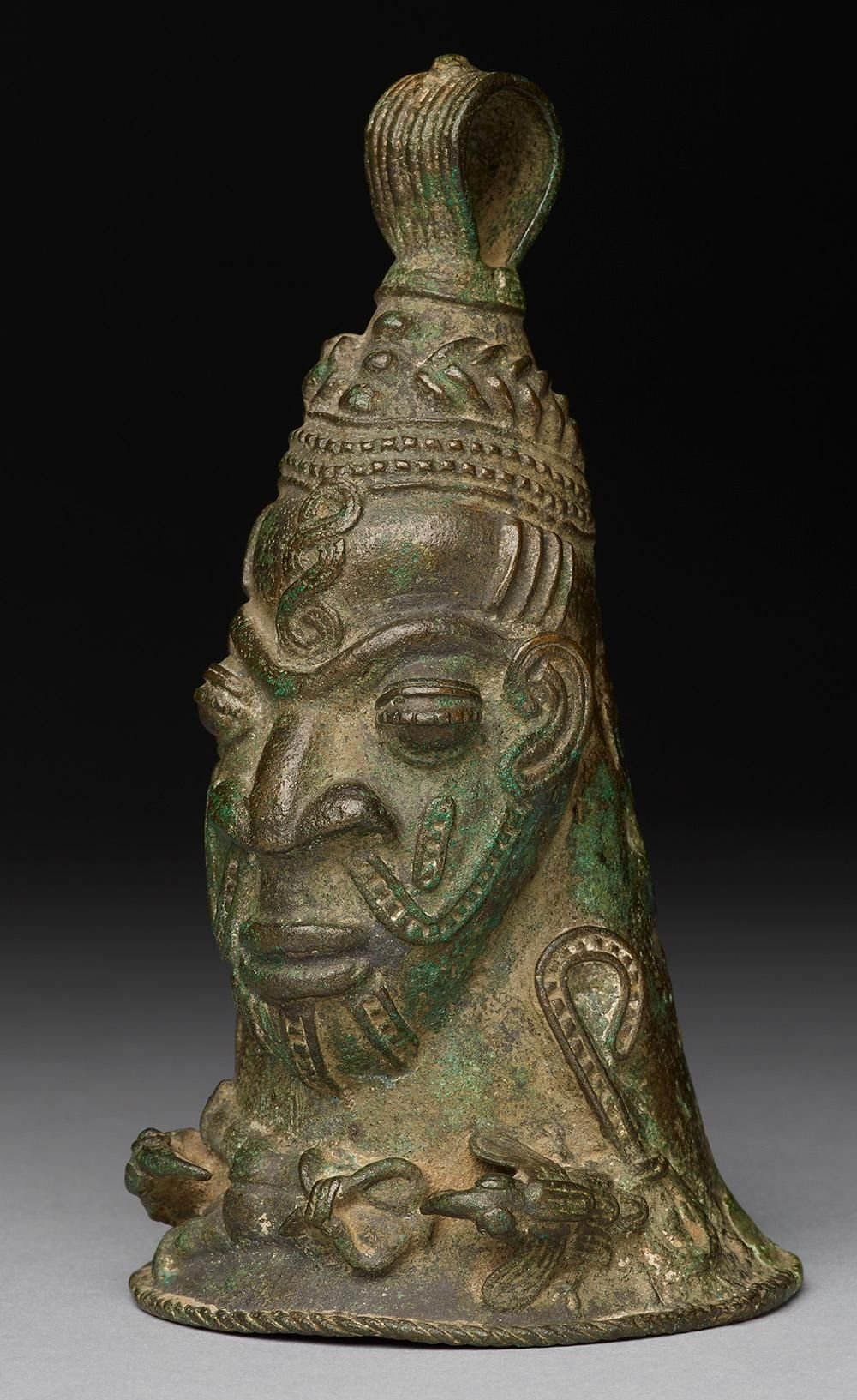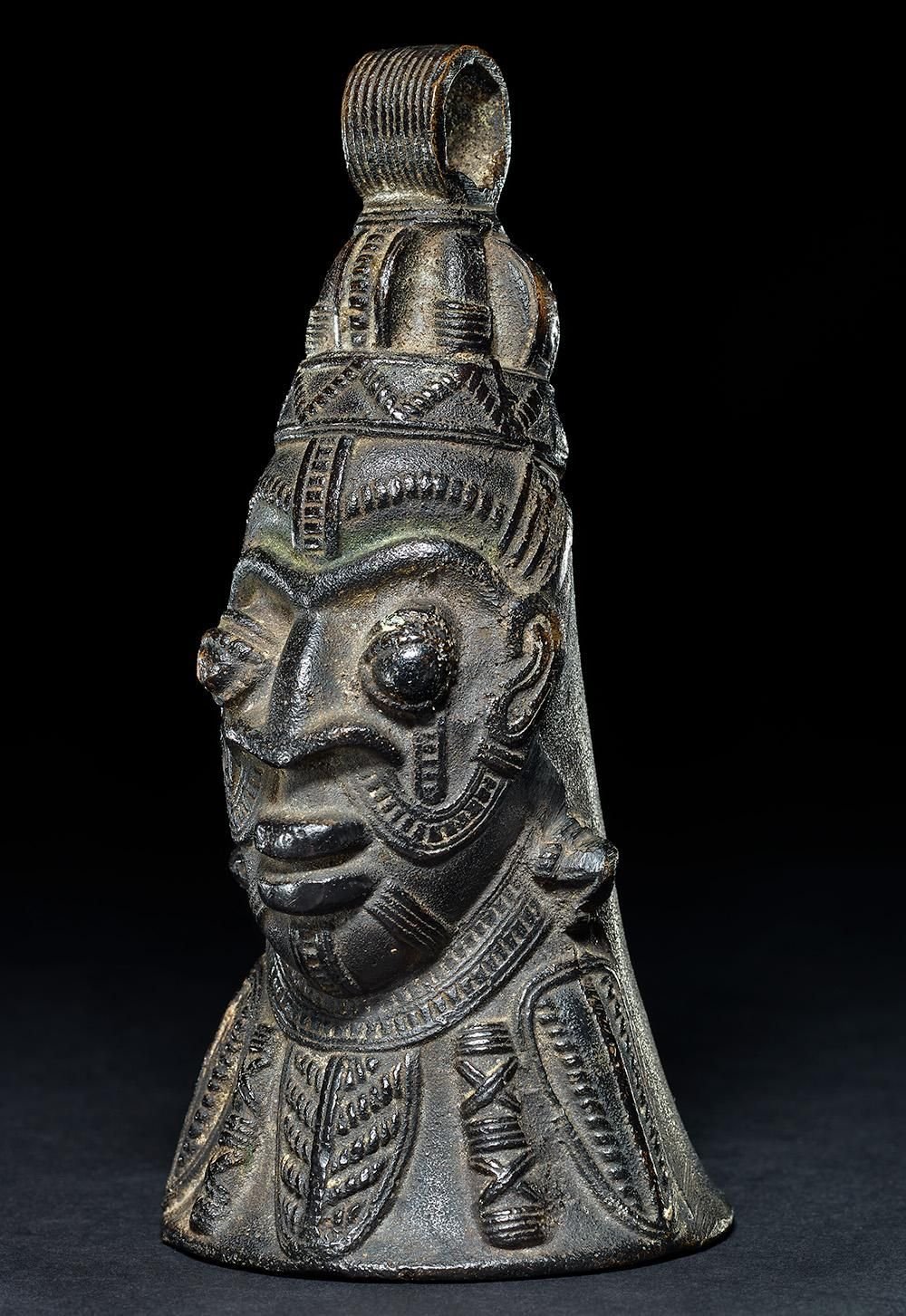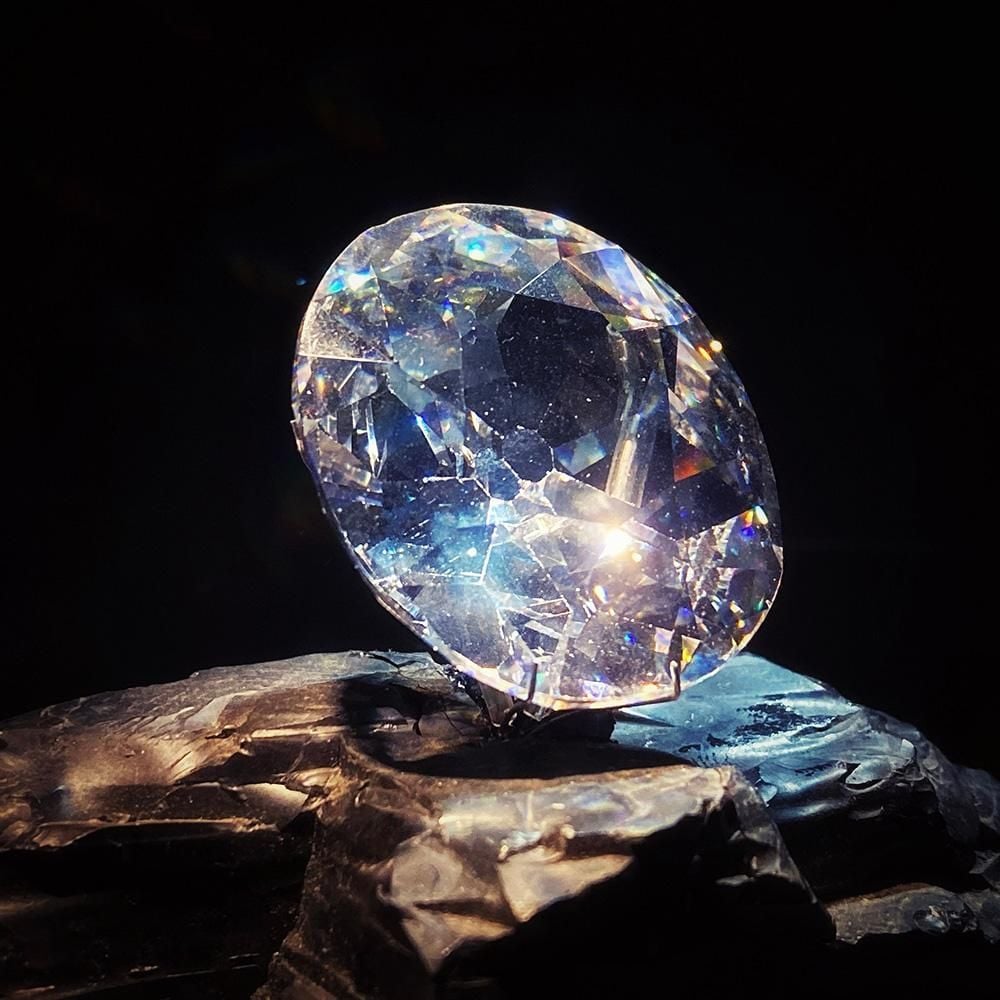Hew Locke: what have we here? is open until 9 February 2025.
Free tickets are now available on all Fridays. Select 'Free on Fridays' when booking your ticket.
Five members of our Youth Collective visited the special exhibition Hew Locke: what have we here?, which explores narratives of British imperialism.
The Youth Collective is a group of 18–24 year olds from a variety of backgrounds who spark conversations and influence change at the Museum. In this blog, we hear from Candice, Ghaf, Ana, Olivia and Sim, who explain why they were drawn to certain objects in the exhibition and how their complex histories made them feel.
Asante soul disc
Candice, 2024 Youth Collective member
Some of the objects in the exhibition are difficult to look at – but at first glance, the 'Gold' table just twinkles and glows. Its centrepiece is a huge golden dish that swirls around a star shape: an awisiado, or soul pendant, from the Asante empire in what is now modern-day Ghana. It was worn by an important priest during spiritual ceremonies.
The pendant was taken as part of the indemnity gold payment after the British sacked the Asante's capital city Kumasi in 1874. Victorian jeweller R & S Garrard & Co later modified it and mounted it onto this elaborate dish.
Look closer and see the differences. The pendant's texture is rougher, its yellow-gold richer. The dish, in contrast, is smooth, its detailing too precise. But some of the gold plating has worn away over time, revealing the silver underneath.
It's part of why gold is so universally important to humans – it doesn't tarnish but endures. Ancient gold jewellery shines and gleams long after its wearer has turned to bones. That pendant, too, might still have been in use today. Instead, it's trapped in that dish, its sacred meaning stripped away and violated.
Of course the British put it into a dish. They had no use for a priest's pendant. To them, it was just a chunk of gold – a trophy, beautiful, exotic and fashionable. There was once a real person who was proud to wear it, who knew its ridges and detailing by touch and felt its weight around their neck. How might they have felt, seeing something so tied to their soul and identity reduced to decoration?
To me, it's one of the saddest objects in the exhibition. Yet I too was drawn to it because it was big, shiny and gold. Colonialism didn't just steal land; it rewrote cultures, identities and spiritualities, twisting them to serve another narrative. It's still happening now, generations later, with cultures being reduced to aesthetics and trends.
As a young person, a lot of what we do is a throwaway culture of fast fashion, takeaway boxes, zero-hours contracts. Thinking about the pendant, I reflected on its permanence: the gold that doesn't change, the losses that can't be undone. Now, only the meaning we give it changes.
Drawing for the imperial shamiana
Ghaf, 2021 Youth Collective member
This drawing is a design for the canopy of the ceremonial tent, known as a shamiana, created for the Delhi Durbar – an event held to commemorate the 1911 coronation of King George V and Queen Mary.
It drew me in, not because it depicts a historical fabric, nor because it has anything to do with a British king, but because it simply looked good.
Sure, maybe that's not enough of a reason to keep drawings for over a hundred years. Of course, the context – of traditional Indian designs commemorating the coronation of a colonial monarch – gives them a powerful story. Yes, we're going to get into that. But first, let's admit it was so good they couldn't leave without it. They had to take the drawings home, along with the physical fabric that now drapes the throne in Buckingham Palace. That good.
Beyond the design, what stood out to me is how the shamiana – a traditional South Asian celebratory tent for outdoor gatherings such as weddings, parties and religious events – symbolises cultural hospitality and community celebration. Yet, in these drawings of the imperial shamiana, this meaning is transformed into a political symbol of British imperialism, for King George V to receive homage in a country the British had colonised. Hospitality becomes a necessity; community turns into a formality. It seems fitting that what was kept and deemed worthy to display at the British Museum is a technical drawing, devoid of the festivity traditionally associated with shamianas. This shift from cultural tradition to imperial demonstration is why I chose this. It was beautiful, but reading into it irked me.
Ts'a-ts'a amulet
Ana, 2021 Youth Collective member
This ts'a-ts'a amulet, a Tibetan artefact made in the 19th century, is an incredibly intricate piece, adorned with images of protection and magnificence. Ts'a-ts'a have been placed in sacred mountains, rivers and crossroads as protective amulets. They were also used in sacred funerary ceremonies to honour the departed on their journeys onward.
The production of the ts'a-ts'a was extremely time-consuming; the maker dedicated both physical craft and soul into its creation as a symbolic amulet for pilgrimage. The amulet often took many months to complete, so the fact it has been removed from its purpose inspired me to explore the soul within.
Some ts'a-ts'a votive offerings made in sacred clay were taken back from pilgrimage and displayed in homes or on monastery altars, connecting the owner with the sacred site. The amulet, through mantra, carries the power of the great teacher or lama. As a young historian with a deep interest in ritual and religious artefacts, this amulet gave me the impression that the owner was of high importance in their community. It brings to life a story of dedication and personal sacrifice through the amulet's vibrant imagery. The way in which I too carry my own amulets, the owner of this amulet carried its power to the next existence. The spirit of the maker and owner shine through the detailed relief, featuring a mighty horse and sacred flowers. Ts'a-ts'a amulets are a true labour of love, passed on through generations, which is deeply inspiring.
The Forcados River bell and Birmingham bell
Olivia, 2023 Youth Collective member
The Forcados River bell originated from the Lower Niger region (now Nigeria) and is dated AD 900–1500. The Birmingham bell is similar in appearance, however, upon closer inspection there is a notable difference.
A registered design mark on the Birmingham bell, which is still visible despite attempts to remove it, shows it was manufactured in England in the late 19th century and is a copy of the Forcados-style of Niger bells.
The exhibition displays the two bells together with a quote from Hew Locke: 'You have what is a British imitation of an African form. It was made for the West African market because people valued them.'
The British imitation of an African object to sell back to the African market for profit seems to me like a form of cultural appropriation and exploitation. The Birmingham bell is a 19th-century example of Western powers culturally appropriating objects through trademarking. The history of these two bells resonated with me as a young person. Discourse around cultural appropriation is more prevalent than ever in popular media, especially in online spaces. The discourse on social media is often too preoccupied with accusing celebrities of cultural appropriation. Seeing the Forcados river bell and Birmingham bell at the Hew Locke exhibition provided a tangible, physical example of cultural appropriation and exploitation.
Koh-i-Noor diamond replica
Sim, 2022 Youth Collective member
The Koh-i-Noor diamond, one of the most famous and contentious jewels in history, embodies a legacy of power, conquest and colonialism. Originally associated with the Mughal empire and later owned by Maharaja Duleep Singh of Lahore, it was forcibly taken following the Second Anglo-Sikh War and presented to Queen Victoria in 1850.
In a post-colonial world, the diamond serves as a stark reminder of Western illusions of superiority at the expense of the Global South. Hew Locke suggests Queen Victoria experienced guilt over acquiring the diamond from Singh but still wore it as a symbol of imperial dominance. This raises the question: is guilt enough to address cultural appropriation and exploitation?
Initially fashioned into a brooch, the Koh-i-Noor later became a centrepiece of the Crown Jewels. Despite its legendary reputation, it somehow failed to impress audiences at the 1851 Great Exhibition. Prince Albert ordered it recut to suit British tastes, reducing it to just 58% of its original size – a symbolic act of cultural and physical transformation.
I imagine this recutting felt like an insult to those in India, who had already lost a significant piece of their monarchic heritage. Today, the diamond's place in the UK evokes similarly complex feelings, particularly for immigrants and descendants of the Global South. It symbolises the pressure to conform to Western ideals, echoing the broader struggles of dual-nationality individuals who may feel disconnected from their heritage. The Koh-i-Noor's journey mirrors the broader inequities of colonial history, leaving a legacy that remains unresolved.
Hew Locke: what have we here? is open until 9 February. Free tickets are now available on all Fridays. Select 'Free on Fridays' when booking your ticket.
We are currently recruiting for our 2025 Youth Collective! The Youth Collective is a group of 18–24 year olds from a variety of backgrounds who spark conversations and influence change at the Museum. Find out more and apply here.

